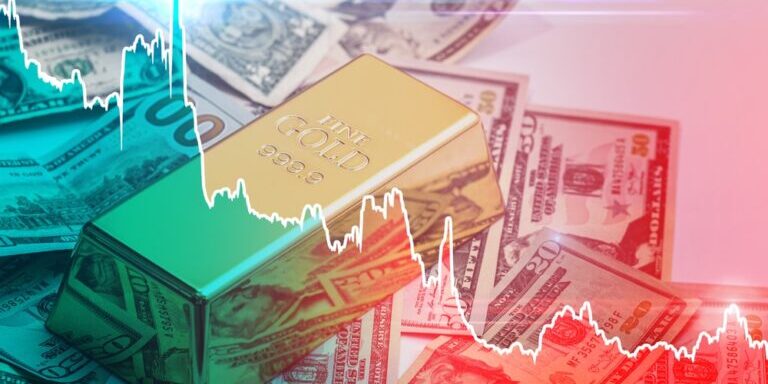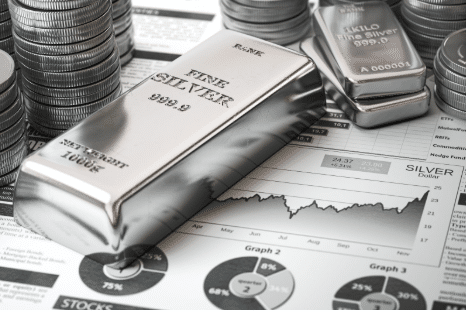
How to Trade Gold (Beginner’s Guide)
Like many precious metals and other commodities, the value of gold changes constantly, because it trades on public exchanges where the price is determined by supply and demand.
The reasons people buy or sell gold, which creates the demand and supply flow, can be for pure speculation, a desire to acquire or distribute physical gold, or as a hedge for commercial reasons. For many day traders, the sole reason to start trading gold is to make a profit from its daily price fluctuations.
Futures Markets
Day trading gold refers to making speculations on its short-term price movements. Physical gold is never actually handled or taken possession of. All transactions take place electronically. You will only see profits or losses reflected in the trading account.
There are so many ways for you to start trading gold. The main way is through a futures contract. This is simply an agreement to buy or sell something (in this case, gold) at a set date in the future. Buying a gold futures contract does not mean that you need to take possession of the physical commodity (and you generally never will). D
ay traders typically close out all of their contracts (or trades) every day and make their profits based on the difference between the price they bought the contract at and the price they sold it at.
The Concept of the COMEX Trading Platform
Gold futures trade on the COMEX trading platform. Standard gold futures (GC) represent 100 troy ounces of gold, and micro gold futures (MGC) represent 10 troy ounces. The gold moves in $0.10 increments only. These increments are called “ticks”.
They are the smallest movements any futures contract can make. Whenever you buy or sell a futures contract, your profit or loss will be determined by how many ticks the price moves away from your entry price. To calculate these profits or losses, you will need to know the tick value of the contract you are trading.
The tick value is $10 for standard contracts. This is because the contract represents 100 ounces of gold, and 100 ounces multiplied by the $0.10 tick size results in $10. That means for each contract, a one tick movement will result in a profit or loss of $10.
If it moves 10 ticks, you win or lose $100. If it moves 10 ticks and you are holding 3 contracts, your profit or loss is $300. For a micro contract, the tick value is $1. This is because the contract represents 10 ounces of gold, and 10 ounces multiplied by the $0.10 tick size results in $1.
That means for each contract, a one tick movement will result in a profit or loss of $1. If it moves 10 ticks, you win or lose $10. If it moves 10 ticks and you are holding four contracts, your profit or loss is $40.
Gold Futures
The amount you need in your account to day trade a gold futures contract will depend on your futures broker. You also need enough in the account to accommodate for potential losses. For a day trade of a standard Gold Futures (GC) contract, you need $2,000 in your account, plus additional funds to accommodate losses.
The amount required by your broker to open a day trading position is called the intra-day margin. This value varies by the broker and is subject to change. These figures assume you are day trading and closing out positions before the market closes each day.
If you continue to hold your positions overnight, you are subject to Initial Margin and Maintenance Margin requirements, which will require you to have more money in your account.
ETFs and Stock Market Trades
Another way to day trade gold is through funds that trade on a regular stock exchange, like the SPDR Gold Trust (GLD). If you have a stock trading account, you can trade the price movements in gold. The trust holds gold in reserve, so the value reflects the price of gold.
The price of the SPDR Gold Trust (which represents gold stocks) is usually about a tenth of the price of gold. So if gold futures are trading at $1500, SPDR may trade at about $150. It trades like any stock. The minimum price movement is $0.01, so you make or lose $0.01 for each share you own every time the price changes by a cent.
Stocks and ETFs are usually traded in 100 share blocks (called round lots) so if the price moves a cent and you are holding 100 shares, you make or lose $1. If the price moves $1, from $120 to $121, you make or lose $100 on your 100 share position.
If you are holding 1000 shares, you make or lose $1000 on that same action. The amount you need in your account to day trade a gold ETF depends on the price of the ETF, your leverage, and position size.
Other Strategies for Trading Gold
It used to be quite hard to trade gold because you had to buy and sell the metal itself, sometimes even by the arduous process of gold mining. But then along came futures and gold options, allowing traders to take positions without actually ending up with a safe full of bars, coins, or jewelry.
Gold exchange-traded funds (ETFs) made it even easier when trading gold became much like trading any other stock. These days, trading gold is almost no different from trading foreign exchange. If a retail investor uses a spread-betting platform it is simply a case of buying or selling depending on whether you think that the gold price is likely to rise or fall.
For some people, trading gold is attractive simply because the underlying asset is physical rather than a number in a bank account. There are a variety of strategies for trading gold ranging from studying the fundamental factors affecting supply and demand, studying the current positioning of gold traders, to technical analysis and studying the gold price chart.
Even if you rely principally on the fundamentals, a better gold trading strategy is to incorporate some components of fundamental, sentiment, and technical analysis. While fundamental and sentiment analysis can help you spot trends, a study of the gold price chart and patterns can help you enter and exit specific trades.
Trading gold is much like trading forex if you use a spread-betting platform. A gold trading strategy can include a mix of fundamental, sentimental, or technical analysis. Advanced gold traders recognize that gold is priced in US Dollars and will account for its trend in their analysis.
Trading Gold or Trading Forex
Gold has traditionally been seen as a store of value, precisely because it is not subject to the whims of governments and central banks as currencies are. Gold prices are not influenced directly by either fiscal policy or monetary policy and will always be worth something.
This is seen in contrast to a currency that can end up being almost worthless due to hyperinflation, for example. Gold can also be used by traders as a “safe haven”, along with assets like the Japanese Yen, the Swiss Franc and the notes and bonds that are issued by the US Treasury.
That means that when traders are worried about risk trends they will tend to buy haven assets. This strategy can act as somewhat of a disclaimer for newer and less experienced investors. On the flip side, traders tend to generally sell these types of haven assets when risk appetite grows, opting instead for stocks and other currencies with a higher interest rate.
This makes gold an important way of hedging against inflation and a valuable longer-term asset. Note, though, that while it is possible to trade the Japanese Yen or the Swiss Franc against many other currencies, gold is almost always traded against the US Dollar.
Therefore, if you trade gold, you will need to take into account the value of the US Dollar. For example, if the value of the US Dollar is increasing, that could drive the price of gold lower. An additional factor to take into account when learning how to trade gold includes the amount of liquidity in the financial market.
The average daily trading volumes in gold are higher than in any currency pairs other than EUR-USD, USD-JPY, and GBP-USD. That makes it higher, for example, than the daily trading volume in EUR-JPY, so the spreads in these financial markets (the differences between buying and selling prices) are narrow, which makes gold relatively inexpensive to trade.
Lastly, gold usually trades for nearly 24 hours per day. Gold exchanges are open almost all the time, with trading hours moving from London and Zurich to New York to Sydney and then to Hong Kong, Shanghai, and Tokyo before returning to Europe.
This means liquidity is always high although, as with foreign exchange, it can be relatively quiet after the New York close, with lower volumes and therefore some volatile price movements. Always keep these time frames in mind when you are trading.
Technical Analysis
Technical traders will notice how the market condition of the gold price chart has changed over the years. Gold prices followed a pretty clear trend from 2005 to 2015. Since 2015, the gold market has remained within a neatly defined range, with the yellow metal often changing hands at values between $1,000 and $1,400.
It is a good idea to match your technical gold trading strategy to the condition of the gold market. If the market is trending, you may want to use a momentum strategy. If the gold chart is range-bound, you might consider a low volatility or range strategy.
As a quick disclaimer: these are advanced techniques so you should only consider using them if you already have some experience trading gold. If you prefer to use technical analysis, the simplest way to start is by using previous highs and lows, trendlines, and chart patterns.
When the gold price rises, a significant previous high above the current level will be an obvious target, as will an important previous low when the price falls. Also in an uptrend, a line on the chart connecting previous highs will act as resistance when above the current level, while a line connecting previous higher lows will act as support.
The reverse is true in a falling market. As for chart patterns, those like head-and-shoulders tops and double bottoms are relevant just as they are when trading currency pairs. If you are a more sophisticated technical trader, Elliott Wave analysis, Fibonacci retracement levels, momentum indicators, and other similar techniques can all help determine likely future moves.

Gold is considered a safe investment so a lot of people buy it in times of financial instability.
Some Final Gold Trading Tips
Returning to fundamental analysis, the beginner needs to consider one point in particular: is market sentiment likely to be positive or negative? If it is positive, then the gold price is likely to fall. If it is negative, it is likely to rise. This is the simplest strategy to use when you are trading gold.
More advanced traders should consider too what is likely to happen to the US dollar. In recent years, the US dollar has become increasingly regarded as a safe haven as well, which explains slightly why the gold price in US dollars has remained relatively stable.
If you think, for example, that the geopolitical situation is going to worsen, you might consider buying gold but also selling, for example, the Australian Dollar against the US dollar. If you are an advanced trader, keep a close watch on the demand for gold jewelry.
Especially in Asian countries, gold jewelry is still seen as an important and durable long-term investment. Gold has plenty of industrial uses too and the buying and selling of gold by central banks can also be important factors that can affect the price.
As for supply, advanced traders will want to keep an eye on the output figures from the main mining companies such as Newmont Mining or Barrick Gold. All the rules of trading forex also apply to trading gold. If you are a trader with a retail investor account, be careful not to over-leverage and be sure to think about risk management. Rather be prepared to set targets and stops, just in case something goes badly wrong.
Get Ready to Start Trading
Remember that for a day trade of stocks or ETFs in the United States, you are required to have at least $25,000 in your account. Depending on how much income you want to generate, you can certainly have more than $25,000 available.
Always consider whether the markets are risky or not. Look at the likely performance of the gold price as well as the US Dollar. Employ a mix of fundamental, sentimental, and technical analysis. Watch out for central bank buying or selling.
Consider the demand for gold jewelry. Look at industrial demand for the yellow metal. And finally, be sure to account for the supply position.
The financial market is crumbling and EVERYONE will be affected. Only those who know what's going on and PREPARE will survive... dare we say thrive. Our 7 Simple Action Items to Protect Your Bank Account will give you the tools you need to make informed decisions to protect yourself and the ones you love.









